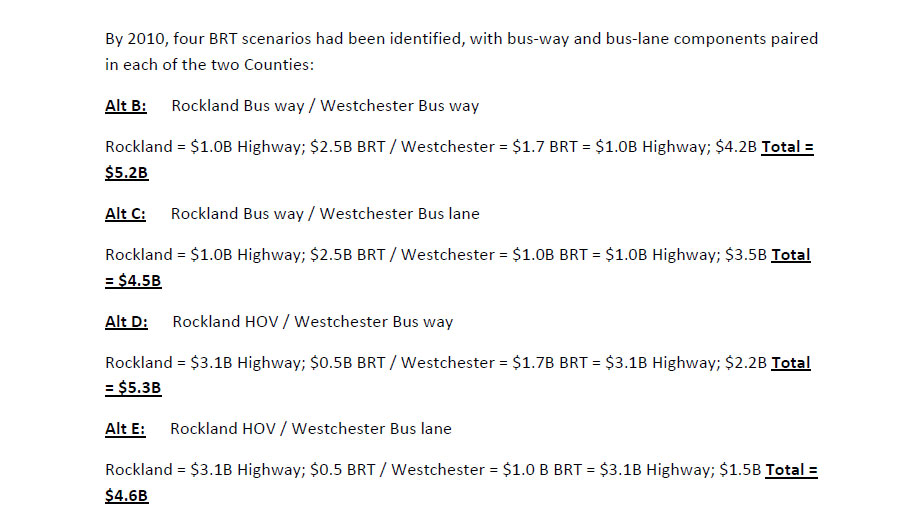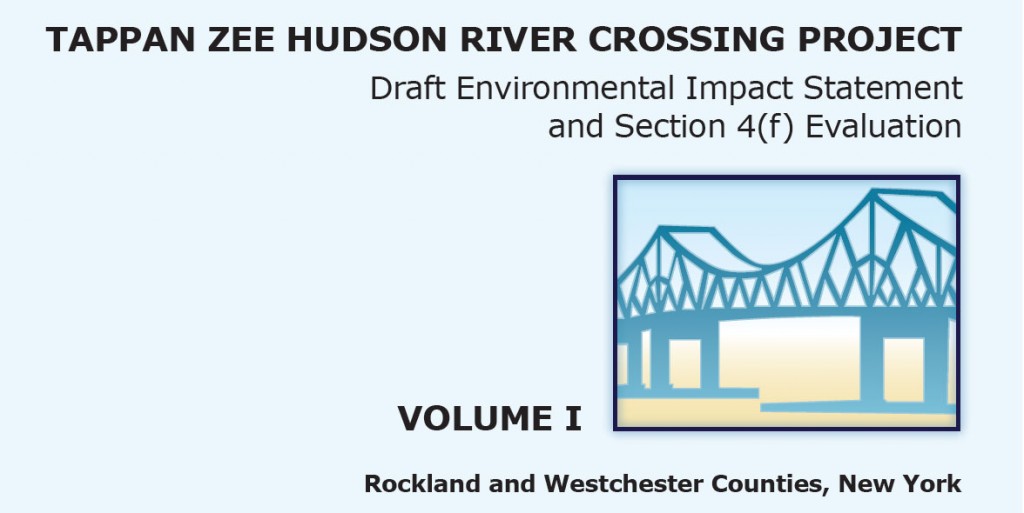The New York State Department of Transportation (NYSDOT) and New York State Thruway Authority (NYSTA) recently released the Draft Environmental Impact Statement (DEIS) for the Tappan Zee Bridge replacement. Despite popular demand for better public transit in the I-287 corridor, the project’s draft environmental impact statement (DEIS) makes few provisions for public transportation in the Lower Hudson Valley. Many residents want a bus rapid transit (BRT) system, and Tri-State has set up a website to advocate for BRT’s place in the project.
Over the next two weeks, a series of Mobilizing the Region posts will explain why the state is wrong to conclude that the Tappan Zee should be built without bus rapid transit. Today, we examine the DEIS’ faulty assessment of the cost of putting transit on the Tappan Zee.
In the DEIS, the state argues that including transit on the Tappan Zee would be too expensive. This conclusion rests on two problematic arguments.
- First, the state asserts that an anticipated $16 billion funding shortfall means there is not enough money to include transit in the project, but it nonetheless manages to find billions of dollars for a multiple span bridge.
- Second, the state’s cost estimates for BRT and commuter rail conflict with previous projections, but this change is not adequately explained.
1. If New York can find money for a bridge, it can find money for a bridge with transit
One justification in the DEIS for excluding mass transit appears to be an anticipated shortfall in funds for state of good repair and normal replacement work (SOGR/NR) over the next 25 years. That is, the cost of necessary infrastructure maintenance work in the Lower Hudson region and New York City exceeds the projected funds available for that work, even before adding in the cost of replacing the Tappan Zee. The exact calculation is as follows:
| NYMTC SOGR/NR funds needed | $986.3 billion |
| NYMTC SOGR/NR funds available | $969.5 billion |
| Projected shortfall | “roughly $16 billion” |
Somehow, this funding shortfall leads the state to believe that the bridge is affordable, while transit is not: “Based upon the information in the recent cost estimates and the current funding levels both from federal and state sources and systematic review of the financial analysis in the various transportation plans, it was determined that funding for the Tappan Zee Bridge/I‐287 Corridor Project (components including bridge replacement, highway improvements, and new transit service) was not financially feasible at this time” (Appendix A-1, p. 5-7).
But the above calculation suggests that no Tappan Zee Bridge work is financially feasible at this time. The state does not say why it can locate money for a bridge but cannot locate money for transit. If funds can be found to rebuild the bridge, one can reasonably assume that transit funds can be found as well.
2. The cost projections for transit in the DEIS are not well-grounded
It is also unclear how the state arrived at its cost estimates for bus rapid transit and commuter rail. According to the DEIS, the bus rapid transit system’s cost “ranges from $4.5 to $5.3 billion” and “$4.4B to $4.6B for the [commuter rail] infrastructure, plus an additional $340M to $620M for modifications to the bridge, or approximately $5.0B for the operable [commuter rail].” These estimates are significantly higher for bus rapid transit and significantly lower for commuter rail than previously projected, but a detailed explanation for the change is not given. Rather, the state says that it has studies but will not publish them. They do provide the following chart:

This is not enough information to understand the changes to the projected costs. Moreover, the transit alternatives analysis ignores the tremendous flexibility and variability of bus systems. There are many ways to add bus service to the I-287 corridor, and it’s highly unlikely that any of them would cost $5 billion—the original $1 billion BRT cost estimate was inflated, and a 2003 GAO report found that a dedicated busway (which is significantly more expensive than a highway bus lane) would cost $13.5 million/mile.
TSTC calls on the state to explain 1) why money can be found for a bridge but not transit, given the $16 billion shortfall, 2) how the project will be funded and 3) the change in cost for bus rapid transit and commuter rail.


Dear TSTC,
Thanks for the call. In response to your questions;
1) Money cannot be found for the bridge or transit. We couldn’t find it, so we’re paying a consultant millions of dollars of borrowed money to tell us that we should borrow more money.
2) The project will be funded with borrowed money (duh).
3) Bus rapid transit and commuter rail will cost more than a bridge without bus rapid transit and commuter rail (duh). That’s why we’re not going to do it.
Love,
The State
I have a suggestion . Just build a rail line Suffern to White Plains and on to connect to the New Haven line and run trains every 15 minutes. Existing bus routes can be adapted to connect to it and the trains will be less expensive to run than the “streamlined” buses that ride the same as regular buses. The line doesn’t even have to be double track all the way if the designers are competent. This line also could be expanded to go to Stewart International airport. Then just patch up the existing bridge because rail will take care of the growth in passenger traffic.
Perhaps the state can use the funds for BRT on Long Island recommended in the LITP2000 Study, which envisioned interconnected BRT operating in dedicated and/or HOV lanes in Nassau and Suffolk Counties, and was vehemently and vociferously denounced by…..wait for it…..the Tri-State Transportation Campaign!!!!! Shame on you, hypocrites.
[…] Tappan Zee DEIS Fails to Explain Cost of Transit or How to Fund Bloated Road (MTR) […]
[…] Tappan Zee DEIS Fails to Explain Cost of Transit or How to Fund Bloated Road (MTR) […]
[…] door on a transit component. Madison again cited numbers, which have been called into question by advocates and the media, that would put the cost of a bus rapid transit system equal to that of commuter […]
[…] door on a transit component. Madison again cited numbers, which have been called into question by advocates and the media, that would put the cost of a bus rapid transit system equal to that of commuter […]
[…] environmental impact statement. Despite repeated inquiries by Streetsblog, other reporters and transportation advocates, the state has offered no explanation for why the cost of bus service suddenly skyrocketed. […]
[…] comments in its Final Environmental Impact Statement. With frustration growing about the DEIS’ unsubstantiated projected transit costs, insufficient alternatives analysis, incomplete environmental review, and […]
[…] is also another matter of the ledger to note: the state’s still-fuzzy math surrounding transit on the Tappan Zee Bridge. Tri-State’s letter to Majority Leader Skelos and […]
[…] is the fifth and final installment of a series of Mobilizing the Region posts that explain why the state is wrong to conclude that the […]
[…] A panel at the conference, which featured Tom McGuinness of the New York State Thruway Authority (NYSTA), Nadine Lemmon of Tri-State, and moderator Ned Sullivan of Scenic Hudson, covered that crucial regional topic. During the discussion, McGuinness noted that NYSTA had “terminated” an earlier Tappan Zee project—one that could have advanced transit throughout the I-287 corridor—citing the costliness of bus rapid transit, even though the project had seen extensive public participation and was uniquely regional in scope. Cost estimates for bus rapid transit have been part of the state’s justification for excluding transit from the Tappan Zee Bridge project that followed the one that NYSTA terminated, but they have not been substantiated. […]